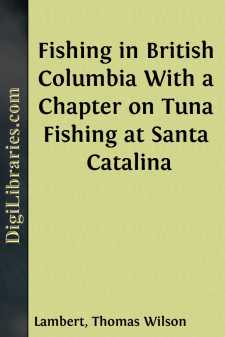Categories
- Antiques & Collectibles 13
- Architecture 36
- Art 48
- Bibles 22
- Biography & Autobiography 813
- Body, Mind & Spirit 142
- Business & Economics 28
- Children's Books 17
- Children's Fiction 14
- Computers 4
- Cooking 94
- Crafts & Hobbies 4
- Drama 346
- Education 46
- Family & Relationships 57
- Fiction 11829
- Games 19
- Gardening 17
- Health & Fitness 34
- History 1377
- House & Home 1
- Humor 147
- Juvenile Fiction 1873
- Juvenile Nonfiction 202
- Language Arts & Disciplines 88
- Law 16
- Literary Collections 686
- Literary Criticism 179
- Mathematics 13
- Medical 41
- Music 40
- Nature 179
- Non-Classifiable 1768
- Performing Arts 7
- Periodicals 1453
- Philosophy 64
- Photography 2
- Poetry 896
- Political Science 203
- Psychology 42
- Reference 154
- Religion 513
- Science 126
- Self-Help 84
- Social Science 81
- Sports & Recreation 34
- Study Aids 3
- Technology & Engineering 59
- Transportation 23
- Travel 463
- True Crime 29
Fishing in British Columbia With a Chapter on Tuna Fishing at Santa Catalina
Categories:
Description:
Excerpt
The Author hopes that this book may prove of some interest to anglers by giving a short account of the fishing which is to be obtained in a part of the world hitherto little exploited, and well worthy of better acquaintance.
British Columbia only became fairly easy of access after the completion of the Canadian Pacific Railway in 1887, which placed it within two weeks' journey from London. Before that time it was cut off by the immense prairies of the north-west of Canada, and could only be reached by a long journey round Cape Horn or over the Isthmus of Panama. Since the date given, however, a new era has dawned for the country, and all the southern part of it has been opened up by railways. Thus its waters have been rendered easy of access to any fisherman willing to try them. The position of the country on the map resembles that of Norway and Sweden in Europe, and the general resemblance is borne out by the features of both countries. Each possesses a deeply indented coast line and a wealth of pine forests, lakes, and rivers. But the climate of British Columbia is much milder; the valleys are richer in soil, the mountains in precious metals, and the waters are inhabited by different species of fish. And whereas the Scandinavian peninsula has some ten millions of people, British Columbia supports as yet but one hundred thousand of population, including Indians.
It is without doubt a country of great possibilities. The summer climate of the southern central plateau is very bracing and dry, resembling that of the southern Californian winter; while the winter climate of the coast is like Devonshire. Game, both large and small, is still plentiful in the south, while the northern part is one of the best big game districts of the world.
British Columbia is the home of the rainbow trout, which flourishes in all its rivers and lakes to the furthest north, and spreads southwards into the neighbouring Pacific states, where it has, however, to compete with another species, the cut-throat trout. The eastern limit of the rainbow is the Rocky Mountain range.
The chief purpose of this book is to give some idea of the habits and peculiarities of the rainbow, and the sport which it affords in its native haunts. The author spent some twelve years in the interior of the country, and has fished a great many of its numberless lakes and streams, so he may claim to write from practical experience. But he writes also with the hope that perhaps someone more competent may in the future publish a complete history of this most interesting fish, and solve some of the problems which are here but alluded to. For there is ample scope in these almost virgin waters for both the naturalist and the fisherman, to whom these notes may perhaps serve as the blazes on a mountain trail, and as some slight record of the sport that was to be obtained in the earlier days of British Columbia.
Though the inland waters swarm with Pacific salmon at certain seasons, the fish are useless for purposes of sport. They take no bait of any kind when they have once started to migrate up the rivers. In the salt water, however, and while waiting at the mouths of rivers, they take a spoon-bait freely, and the smaller kinds will in the same conditions often rise readily to the fly....


